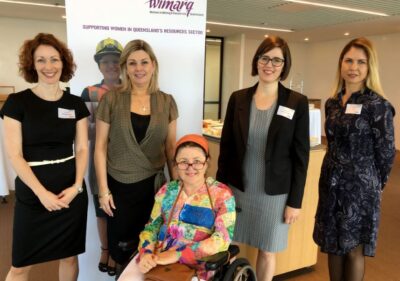Women in Mining and Resources Queensland (WIMARQ) is a group of volunteers who support, mentor and encourage women in the minerals and energy sectors. WIMARQ champions gender diversity by sharing information about gender diversity issues, strategies and statistics, and welcomes women and men from across the sector to their events in Brisbane and regional locations.
Maria Joyce is Committee Chair of WIMARQ. She’s also a mining engineer and the General Manager of engineering consulting firm MEC Mining in Brisbane, Queensland.
Fast facts
- WIMARQ was set up in 2005 “because there was no forum in Queensland for resources sector women in all occupations to meet and network,” says Maria.
- Members range from university students through to women in senior roles in their late 50s and early 60s. They represent almost all occupations – from operators to chief executives – covering geologists, engineers, lawyers and HR professionals.
- The group has around 1,000 subscribers to its website, 3,000 Facebook followers and over 3,000 in its LinkedIn group. “That’s an engagement of about 50 percent of our female workforce in Queensland’s resources sector.”
Q&A with Maria Joyce – Chair
 What is WIMARQ’s vision?
What is WIMARQ’s vision?
Our vision is to create a diverse community of passionate people collaborating to connect, nurture and support women to achieve their goals within the Queensland minerals and energy sector.
What is the group’s top priority?
Creating a personal and virtual network of women in the Queensland resources sector to share issues, knowledge and ideas in a safe and inclusive environment.
What are some of its successes?
We set up the annual Resources Awards for Women with the Queensland Resources Council (QRC). This led to the creation of awards in every Australian state and territory and the instigation of the Women in Resources National Awards, which takes finalists from the state awards.

WIMARQ also partners with the QRC to host the annual International Women’s Day Breakfast, which started in 2006 with 200 guests and has grown in attendance to 1,000 – with about 300 of those watching via live webcast at simultaneous breakfasts across the state.
Since 2005, WIMARQ has organised the hosting of more than 100 events involving about 6,000 people.
What activities and programs is WIMARQ running?
We hold breakfasts, lunches and evening networking events with the help of industry sponsors. Our biggest event is the International Women’s Day Breakfast.
WIMARQ and the QRC also conduct an annual mentoring program for women in our sector in Queensland, and this year we have matched 60 mentees with 60 high-level mentors from our sector. It’s funded through sponsorship and the support of member companies, many of whom support the mentee fee for their employees. We’ve been running this for four years now and more than 100 women have completed the program. Many report that the experience has been life-changing.
Do you coordinate with other groups in the country?
We cooperate with other state bodies through our awards and have a good relationship with Women in Mining Network (WIMnet), which is part of the Australasian Institute of Mining and Metallurgy (AusIMM).
Do you get any support from government or industry?
We have had support from the Queensland Government for our mentoring program. Members of the QRC are very supportive in hosting events and providing sponsorship funds for the mentoring program and the International Women’s Day Breakfast.
What about links to education?
WIMARQ assists the QRC from time to time by providing women in the sector to speak to students through the QRC’s network of schools under its Queensland Minerals and Energy Academy. Our WIMARQ committee members actively volunteer their time and seek out industry events at universities, QLD conferences and the like to share their stories with women already a part of and interested in joining the mining and resources sectors.

In your opinion, what is the outlook for the sector?
It has had some pretty tough years, however there are very positive signs that we’re now coming out of that. A sense of optimism has returned to the sector. Mining is a cyclic industry by nature and the QLD Mining community are nothing short of resilient. I believe exciting times are ahead, as the industry continues to push itself to drive efficiency, embrace innovation and take these challenges in our stride.
How can we get more women on boards?
Companies just need to look around their boardrooms and see who’s missing – not just women, but also people of different ages, experience, backgrounds and cultures. There’s plenty of evidence that diverse boards produce better results for their companies.
Companies need to cast the net wider and think about the skills and experience of women, rather than a prescriptive career path. They need to take a risk; it’ll be worth it! Something very practical would be for board directors to select high-performing women to shadow them and act as alternates, thereby introducing them to a network of board directors and increasing their skills. Employers should give women access to training, such as company director courses, to prepare them for these roles.
And women should back themselves and put their hands up, even if they think they are not qualified. Chances are they are as qualified as many people already on a board.


